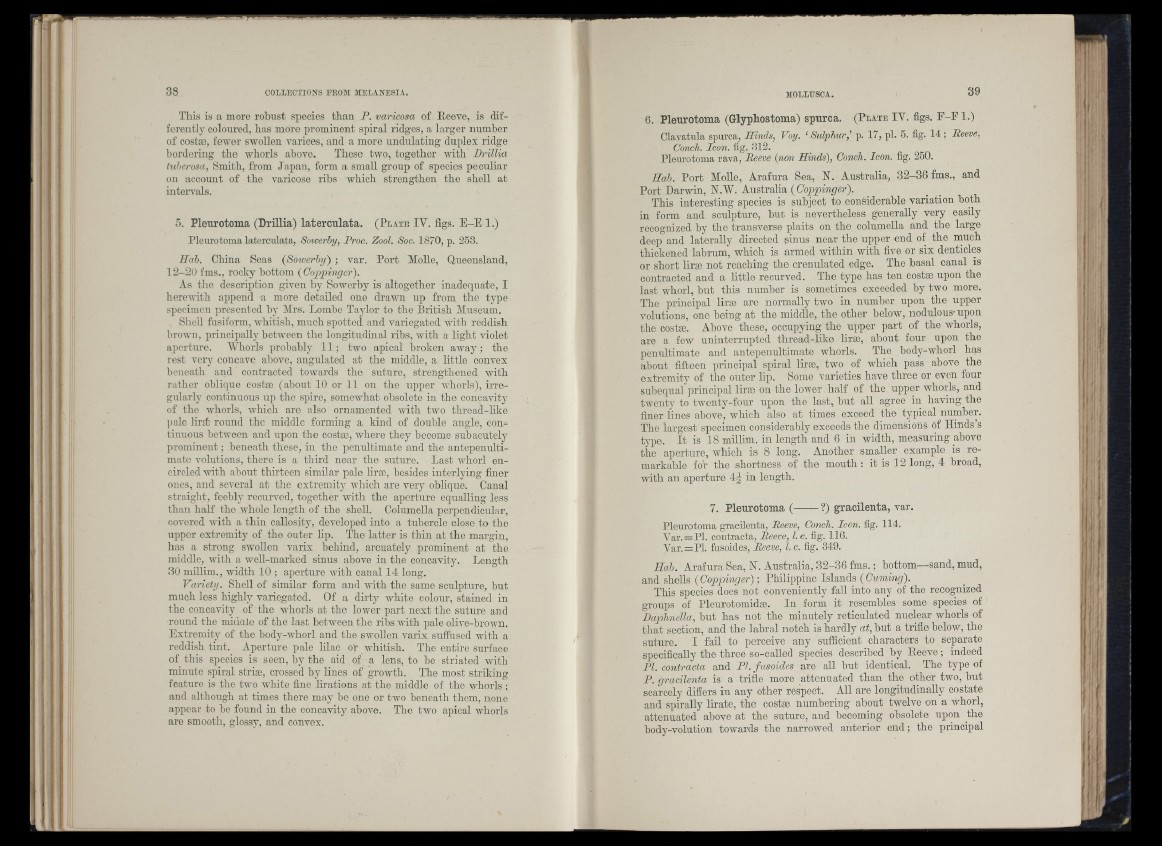
This is a more robust species than P. varicosa of Reeve, is differently
coloured, has more prominent spiral ridges, a larger number
of costæ, fewer swollen varices, and a more undulating duplex ridge
bordering the whorls above. These two, together with Drillia
tuherosa, Smith, from Japan, form a small group of species peculiar
on account of the varicose ribs which strengthen the shell at
intervals.
5. Pleurotoma (Drillia) laterculata. (P late IV. figs. E -E 1.)
Pleurotoma laterculata, Sowerhy, Proc. Zool. Soc. 1870, p. 253.
Hah. China Seas (Soiverhy) ; var. Port Molle, Queensland,
12 -2 0 fms., rocky bottom (Coppinger).
As the description given by Sowerhy is altogether inadequate, I
herewith append a more detailed one draAvn up from the type
specimen presented by Mrs. Lomho Taylor to the British Museum.
Shell fusiform, whitish, much spotted and variegated with reddish
broAvn, principally between the longitudinal ribs, with a light violet
aperture. V^horls probably 1 1 ; two apical broken away ; the
rest very concave above, angulatod at the middle, a little convex
beneath and contracted towards the suture, strengthened with
rather oblique costæ (about 10 or 1 1 on the upper whorls), irre-
gularljr continuous up the spire, somewhat obsolete in the concavity
of tho whorls, which are also ornamented with two thread-like
pale lirdi round the middle forming a kind of double angle, continuous
between and upon the costæ, where they become suhacntely
prominent ; beneath these, in the penultimate and the antepenultimate
volutions, there is a third near the suture. Last Avhorl encircled
with about thirteen similar 7>ale liræ, besides interlying finer
ones, and several at the extremity which are very oblique. Canal
straight, feebly recurved, together with the aperture equalling less
than half the Avhole length of the shell. Columella perpendicular,
covered with a thin callosity, developed into a tubercle close to the
upper extremity of the outer lip. The latter is thin at the margin,
has a strong swollen varix behind, arcuately prominent at the
middle, with a well-marked sinus above in the concavity. Length
30 millim., width 10 ; aperture with canal 14 long.
Variety. Shell of similar form and with the same sculpture, but
much less highly variegated. Of a dirty white colour, stained in
the concavity of the whorls at the lower part next the suture and
round the miutiie of the last between the ribs with pale olive-brown.
Extremity of the body-whorl and the swollen varix suifused with a
reddish tint. Aperture pale lilac or whitish. The entire surface
of this species is seen, by the aid of a lens, to be striated with
minute spiral striæ, crossed by lines of growth. The most striking
feature is the two white fine lirations at the middle of tho whorls ;
and although at times there may be one or two beneath them, none
appear to he found in the concavity above. The two apical whorls
are smooth, glossy, and convex.
6. Pleurotoma (Glyphostoma) spurca. (P late IV. figs. E-El.)
Clavatula spurca, Hinds, Voy. ‘ Sulphur,’ p. 17, pi. 5. fig. 14 ; Peeve,
Conch. Icon. fig. 312.
Pleurotoma rava, Reeve (non Hinds), Conch. Icon. fig. 250.
Hah. Port Molle, Arafura Sea, N. Australia, 32-36 fms., and
Port Darwin, N.W. Australia (Coppinger).
This interesting species is subject to considerable variation both
in form and sculptnro, but is nevertheless generally very easily
recognized by tho transverse plaits on the columella and the large
deep and laterally directed sinus near the upper end of the much
thickened labrnm, which is armed within with five or six denticles
or short liræ not reaching the crenulated edge. The basal canal is
contracted and a little recurved. The type has ten costæ upon the
last whorl, but this number is sometimes exceeded by two more.
The principal liræ are normally two in number upon the upper
volutions, one being a t the middle, the other below, nodulous-upon
the costæ. Above these, occupying the upper part of the wtoorls,
are a few uninterrupted thread-like liræ, about four upon the
penultimate and antepenultimate whorls. The body-whorl has
about fifteen ]nlncipal spiral liræ, two of which pass above the
extremity of tho outer lip. Some varieties have three or even four
subeqnal principal liræ on the lower half of the upper whorls, and
twenty to tAventy-fonr upon the last, hut all agree in having the
finer lines above, which also at times exceed the typical number.
The largest specimen considerably exceeds the dimensions of Hinds’s
type. I t is 18 millim. in length and 6 in width, measuring above
the aperture, which is 8 long. Another smaller example is remarkable
for the shortness of the mouth
with an aperture in length.
it is 12 long, 4 broad,
7. Pleurotoma (------ ?) gracilenta, var.
Pleurotoma gracilenta, Reeve, Conch. Icon. fig. 114.
Var. = PI. contracta, Reeve, I. c. fig. 116.
Var. =P1. fusoides, Reeve, I. c. fig. 349.
Hah. Arafura Sea, N. Australia, 32-36 fms. ; bottom—sand, mud,
and shells (Qop+myer); Philiiipine Islands (Qitmmy).
This species does not conveniently fall into any of tho recognized
groups of Pleurotomidæ. In form it resembles some species of
Daphnella, but has not the minutely reticulated nuclear whorls of
th at section, and the lahral notch is hardly a i,h u t a trifle below, the
suture. I fail to perceive any sufficient characters to separate
specifically the three so-called species described by Reeve ; indeed
PI. contracta and PL fusoides are aU but identical. The type of
P. gracilenta is a trifle more attenuated than the other two, hut
scarcely differs in any other respect. All are longitudinally costate
and spirally lirate, the costæ numbering about twelve on a whorl,
attenuated above at the suture, and becoming obsolete upon the
body-volution towards the narrowed anterior end ; the principal
i,!
I; /